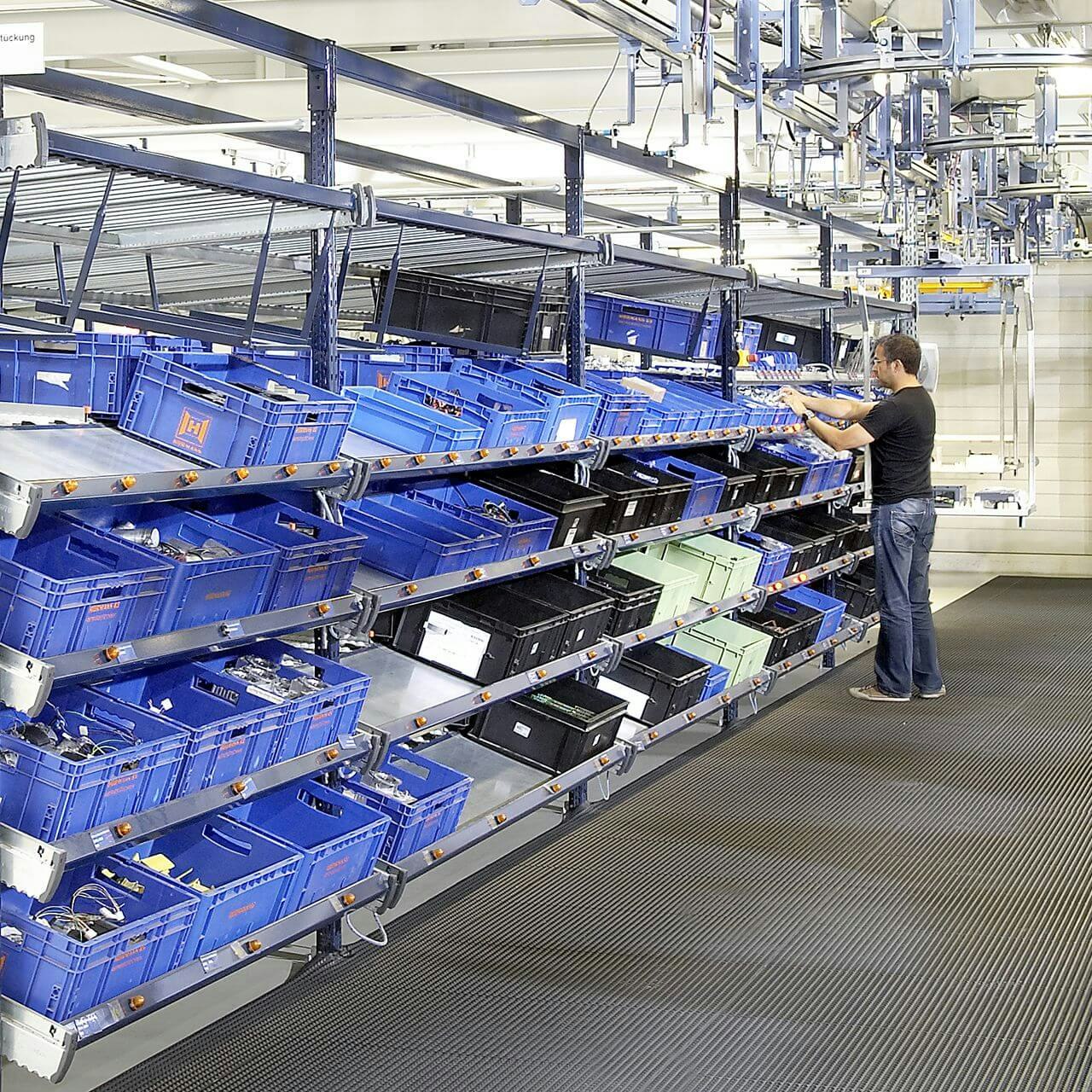Influence of stock turn on warehouse planning and storage

Layout and optimal storage infrastructure are among the many things to consider when planning a warehouse – and each project will depend on a variety of factors. Essentially, the warehouse should allow for the highest turnover rate and the best use of space. Items need to be easily accessible, able to be efficiently handled and quality checked when required. Warehouse layout and storage infrastructure will depend significantly on the type of goods stored. In addition to the physical condition of the goods, economics will also have an influence. And it is here that the key factors of turnover and stock turn come into play.
What are inventory turnover and rotation?
The stock turnover rate (1) expresses how often average stock is withdrawn and replaced in a certain period, typically a financial year. The given figure can refer to the entire warehouse or to parts of the facility. The ratio is particularly important for inventory management as it can be used to minimise capital tied up (2) in the goods. The liquidity of a company decreases with the size of the inventory. In an extreme case, if there are no more financial resources to pay outstanding liabilities, the company is threatened with insolvency. The higher the turnover rate, the more profitable the business and the lower the capital commitment.
The rotation of goods (1) is the speed at which goods are sold. It can also be defined as the turnover rate of a product. The faster a certain product sells, the higher its commodity rotation or turnover rate. Goods or products are divided into fast-moving items (fast sellers), medium and slow-moving items (slow sellers) often referred to as an ‘ABC analysis’. Fast moving items sell particularly quickly, which means that they have a high product rotation – an important factor for procurement, logistics, warehousing, order picking and distribution. Fast Moving Consumer Goods (FMCGs) are often daily used items that are bought quickly and without large investment. Storage time is usually very short, which means that they occupy minimal storage space and only incur low storage costs. Slow moving goods have precisely the opposite characteristics: usually in storage for a longer period of time and occupying more storage space because they are only in demand very rarely or only seasonally. There may be other reasons for the low demand, such as a price that is too high or wrong product placement. However, by taking up storage space, slow-moving items incur storage costs, so it is therefore important for a business to have good product range planning(3).
In addition to their rotation, the fluctuating consumption of individual products should also be taken into account – for example, are goods heavily seasonal in their consumption & purchase? For this purpose, SKUs in a company's assortment are divided into demand or consumption classes by means of the XYZ analysis. The X class is characterised by regular consumption. Y class SKUs are consumed irregularly,but with a recognisable trend. Products in the Z class show completely irregular consumption. This tool can therefore be used to estimate the demand on a company's logistics and intralogistics operations over a period of time. This provides a planning basis for the possible purchase of services or outsourcing as well as for personnel recruitment. For general corporate planning and marketing, both ABC & XYZ methods are usually combined.
Calculation of stock turnover rate and rotation of goods
The calculation of the ‘stock turnover rate’ is an essential tool to understand how well stock is being utilised by a business:
Turns per year can be calculated for each category of SKU to help determine the type of infrastructure required in a storage facility.
If the stock turnover rate increases, the storage period decreases and vice versa. The lower the storage period, the higher the goods rotation. This shows that fast moving items have a high turnover rate and thus a shorter time on the shelf, which corresponds to a high goods rotation. It is usually expressed in rotations per year, but depending on the sector, also per month, week or even day.
Annual stock turnover rate = stock shipped / (opening stock + closing stock)/2
For example : £520,000/ (£150,000 + £160,000)/2 = 3.3 turns per year
Another simple way to measure performance is to calculate the number of days required to turn stock.
In the earlier example, the number of days (excluding weekends) required to turn stock is:
260/3.3 = 78 days
How does the rotation of goods affect stock planning and warehousing?
Fast-moving items are allocated preferential locations. Placing products with a high turnover rate close to the storage and retrieval area keeps average travel distances in the warehouse short and enables quick access. This allocation strategy requires precise knowledge of the turnover rate or rotation of goods. Of course, the speed of sales will also influence procurement, distribution logistics and order picking.
To further optimise warehouse processes, warehouses are often also divided into zones according to SKU turnover rate: fast, slow and medium moving. Since fast moving items are sold quickly and only stay in the warehouse for a short time, they will require tailored storage technology and racking systems. For this reason, unit load or pallet flow Dynamic Storage (DS) racking (4) is often chosen for fast-moving items. DS racking offers many advantages, especially for storing fast and medium-moving items. The storage and retrieval sides are clearly separated, which means goods can be stored undisturbed on one side and retrieved on the other side of the flow rack. The goods run independently through the channel of the DS due to the inclined nature of the roller conveyors. DS also ensures that the ‘First In First Out’ (FIFO) principle is followed, while guaranteeing optimum batch monitoring. This makes it particularly suitable for perishable goods with expiry dates, such as food or medicines. BITO offers the PROflow flow rack system for pallets (5) and SDS-T or FLEX for unit loads (6). Slow-moving goods can be stored in normal shelf or pallet racking because of their long storage time.
Literature:
1 TUP Editorial, Definition, Inventory turnover and rotation of goods: fast and slow movers, Logistik KnowHow, Link
2 Why your liquidity is so important, PostFinance, January 2019, Link
3 BITO Expertise, Optimal assortment design leads to leaner logistics, Link
4 BITO expertise, Which type of storage technology suits your company, Link
5 BITO pallet flow rack system (PDS), Link
6 BITO unit load flow rack system (SDS), Link


